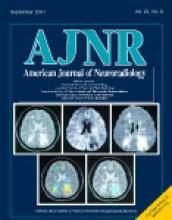Abstract
BACKGROUND AND PURPOSE: Increased fat content in vertebrae may indicate bone weakness. Vertebral proton MR spectroscopy (1H MRS) quantitatively measures vertebral fat relative to water. Thus, 1H MRS measurements of percent fat fraction (%FF) and spectral line width (LW) of vertebral bone marrow may differ between subjects with and those without MR imaging evidence of weakened bone.
METHODS: We measured %FF and LW in 22 subjects with (15 men and 7 women, aged 26 to 80 years) and 72 control subjects without (33 male and 39 female subjects, aged 15 to 87 years) MR findings of weakened bone, including prominent Schmorl's nodes, endplate depression, vertebral wedging, and vertebral compression fractures. In those with bone weakness, 1H MRS data were sampled from an intact vertebra, usually L2. Data were analyzed for differences by age and sex. We compared the mean %FF and LW in subjects with and in those without bone weakness by use of Student's t test.
RESULTS: The %FF increased linearly with age in the control subjects, ranging from 20.5% in the second and third decades of life to 49.4% in eighth or ninth decades of life. Across all age groups, male control subjects had a higher aggregate %FF than did female control subjects. Male control subjects tended to have a greater LW than did female control subjects, but differences between the sexes within or across age groups were not significant. Contrary to expectations, LW was greatest in the oldest control subjects and lowest among younger control subjects, but there were insufficient data points to make definitive conclusions. Overall, %FF was a relative 45% higher in subjects with weakened bone compared with control subjects (48.8 vs 33.6 [P < .001]). The subjects with evidence of vertebral bone weakness also had a higher overall mean LW (37 vs 29 Hz [P < .002]), but this finding is of uncertain importance.
CONCLUSION: The %FF was significantly higher within the L2 vertebral body in 22 subjects with weakened bone compared with the control group, suggesting that it could serve as a measure of bone quality. The LW measurements did not yield meaningful conclusions.
- Copyright © American Society of Neuroradiology












